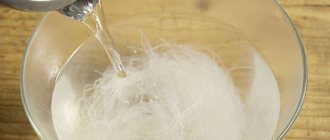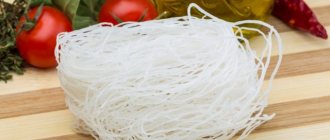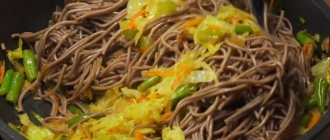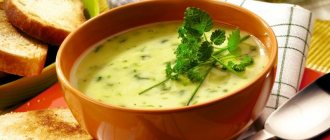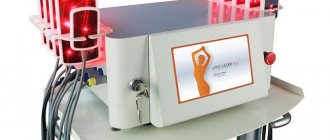What is funchose?
Funchoza is a product that came to us from Asia, made from dry noodles with seasonings from stewed vegetables. Funchoza is served as a hot or cold dish. Noodles are rarely prepared as a separate, independent dish because they do not have distinct flavors. They like to call funchoza “glass noodles” because when cooked, it becomes transparent and resembles glass.
Glass noodle recipes
We offer various recipes for dishes with funchose to diversify your menu.
Vegetable funchose
The calorie content of the dish is about 580kC/100g. The dish contains the following ingredients:
- noodles – 0.5 kg;
- pork meat – 0.3 kg;
- carrots – 2 pcs;
- radish – 1 piece;
- onion – 1 piece;
- soy sauce – 1 tbsp;
- garlic – 3 cloves;
- vegetable oil – 1 tbsp;
- salt, spices.
Finely chop the meat - pork or beef. Onions are chopped into rings, and carrots and radishes into strips. The meat is placed in a frying pan and fried in oil. Add vegetables, salt and pepper. After a few minutes, squeeze out the garlic and soy sauce.
Add funchose to boiling water and cook for 5 minutes, stirring constantly. The finished vermicelli is washed under cold water and placed on a dish. Add meat with sauce and mix. Serve warm.
Salad
100g of salad with funchose contains only 278kC. Therefore, there is no reason to refuse such an amazing dish! For preparation you need:
- noodles – 0.2 kg;
- meat – 200g;
- cabbage – 50g;
- carrots – 1 piece;
- garlic – 3 cloves;
- radish – 1 piece;
- onion – 1 piece;
- pepper – 1 piece;
- jusai – 20g;
- salt, spices.
The noodles are boiled for 5 minutes and washed in a colander. Vegetables are fried in vegetable oil. The meat is cut into slices and stewed in oil. At the end of cooking, add green jusai, spices, and salt. Place meat, noodles and vegetables in a salad bowl. The ingredients are mixed and served cold.
Photo#7
Korean glass noodles
In just 20 minutes you can prepare a delicious dish. Calorie content – only 210kC/100g. For the recipe you will need:
- Funcheza – 400g;
- Korean carrots – 200g;
- Soybean meat – 100g;
- Radish – 1 piece;
- Soy sauce, paprika and lemon juice.
Fry vegetables in vegetable oil for 6 minutes, then add soy meat. Pre-soak the soybeans in hot water to soften them. The mix is cooked for another 5 minutes. Glass noodles are boiled in boiling water for no more than 3 minutes. After straining, let the noodles cool. Mix ingredients and add seasonings.
How is funchose useful?
Most importantly, funchose contains many vitamins and microelements useful for the human body. Also, glass noodles are rich in amino acids. By consuming funchose, you will protect yourself from digestive system disorders.
Thanks to its good composition, noodles protect our body from infections, strengthen the musculoskeletal system, increase visual acuity, normalize the activity of the nervous system and regulate metabolic processes.
Funchose made from green beans is a good replacement for regular pasta and does not contain gluten, which is dangerous for allergy sufferers.
Glass noodles are good for the elderly because they are a product of longevity.
In addition to older people, funchose is not dangerous for pregnant women who are breastfeeding. But during this period it is better not to add hot and hot seasonings to it, but to use funchose only in preparing salads.
What does it consist of?
The composition of the product is simple - just a few components. To prepare funchose, mung beans, corn starch, water and peas are used. When all the ingredients are thoroughly mixed, the raw material for glass noodles is obtained.
Knowing what funchose consists of, fitonyashki use natural noodles in their menu to restore strength after training. The tasty product does not contain flavorings, flavor enhancers, or preservatives.
The beneficial nutrient contains a lot of thiamine, as well as vitamins B6 and E. Minerals include calcium, phosphorus, zinc and selenium. A wide range of microelements helps improve the gastrointestinal tract and has a positive effect on the nervous system. Funchoza is known for its properties to remove toxins and reduce the number of fat cells.
Is it possible to cook glass noodles while on a diet?
Dry funchose has a fairly high calorie content, about three hundred and twenty calories per hundred grams, and for some reason nutritionists still recommend using funchose for those losing weight, and all because when we cook noodles, it absorbs a lot of liquid and becomes a low-calorie product. When the noodles are ready, they contain only ninety calories.
How to cook funchose at home - cooking rules
To prevent funchose from sticking together and losing its taste when preparing it at home, you need to follow these rules:
- If the thickness of the noodles is less than ½ mm, do not cook them, but pour boiling water over them and leave for 3-4 minutes.
- Thicker noodles are cooked in a large amount of water, which should boil strongly during the cooking process.
- To prevent thin threads from sticking together, you can add a few drops of olive oil to a pan of water.
- It is best to cook the noodles “back to back” before the feast - if left for at least an hour, the funchose loses its taste and turns into a solid lump of flour.
- The readiness of the product can be determined by its color - the noodles become transparent, with a barely noticeable grayish tint.
- Immediately after cooking, the product must be rinsed under running cold water.
- Additionally, the noodles can be fried a little.
- The optimal cooking time is indicated on the packaging.
What is funchose made from?
Noodles are made from bean starch, such as mung, and less often from potato starch, yam and others. Now more and more manufacturers have begun to make noodles from corn starch, but the thing is that corn starch does not give funchose the same taste as beans. And some factories produced noodles from corn starch, with the addition of bleach, which contained lead, which is harmful to consumers.
The benefits of real funchose and the danger of fakes
The benefit of the product lies in its composition, rich in vitamins and minerals, as well as in the high content of slow carbohydrates, which saturate the body for a long time.
Useful properties of funchose:
- Vitamin and nutritional composition.
- Can be consumed during a diet as a source of complex carbohydrates.
- Strengthens the nervous system thanks to B vitamins.
- It has a beneficial effect on the structure and functioning of the dermis, promotes regeneration and helps maintain youthful skin for a long time.
- Helps reduce daily intake of fat and sugar, as it provides enough energy for muscle tissue, ensures good health and a boost of energy.
Danger of counterfeits:
Original noodles, which were made under the right conditions and from high-quality ingredients, are absolutely safe for health and cannot cause harm.
Another thing is that even in well-known restaurants (in chain supermarkets and even more so) you can run into a fake. It is not critical if the manufacturer replaces bean starch with corn starch - in this case, only the taste and nutritional value will suffer. But some fakes can be life-threatening. There have been cases when manufacturers deliberately bleached cheap raw materials with lead, endangering the consumer.
How to choose a good funchose?
When choosing funchose, be sure to look at the composition so that it does not contain impurities and chemicals. Also, you should not choose cheap noodles; by choosing an inexpensive product, you increase the risk of “getting caught” by a bad composition. But if you don’t have time to go and choose, you can use our online store, here you can find and order high-quality funchose
Selection and storage of noodles
This product can be found not only in Asian countries. There are many types of bean noodles on the shelves of domestic stores and supermarkets.
Choosing funchose correctly:
- It is recommended to buy a product made in China or Korea if the composition of funchose is indicated on the packaging in Russian.
- It is important to pay attention to the ingredients: real glass noodles are made only from beans. Packages of funchose usually indicate “Green bean vermicelli” or “Bean noodles”. If corn or potato starch is present as the main component, it is a fake product.
- Noodles are sold in portioned bundles, “nests” or large packages of 6-8 pieces.
- It is very important that funchose contains no harmful metals and chemicals. For this purpose, it should be purchased only in large retail chains, where the products undergo sanitary control. In small shops and markets there is a high risk of selling fake noodles.
The shelf life and taste of funchose depend on proper storage. The noodles are placed in a glass, closed container and stored indoors, protected from sunlight. The room should be free of humidity and foreign odors. Funchoza quickly absorbs them, which leads to spoilage of the product.
Is it worth freezing ready-made funchose?
Sometimes housewives cook for future use or have extra food left over, which they usually freeze. What to do with boiled funchose? It is considered undesirable to freeze the product because it loses its valuable properties . Especially if the noodles contain additives. But in extreme cases, small funchose with a diameter of over 1 mm is frozen. Defrost it immediately in a frying pan with mussels, shrimp or stew. But it is not recommended to prepare salads from such funchose.
What is the difference between rice noodles and funchoza?
Many people consider rice noodles and funchose to be the same thing, but this is a big misconception.
1. Rice noodles are made from rice flour, and funchose is made from starch.
2. Rice noodles have a rich white color, which remains the same when cooked, unlike funchose, which becomes completely transparent.
Based on these facts, it can be understood that these products are completely different, I hope.
Funchoza in the diet
Funchoza in the diet of children, pregnant and lactating mothers, diabetics and allergy sufferers:
- You can safely include glass noodles in the diet of pregnant women and children. Not only will it not harm growing organisms, but it will also be beneficial.
- Funchose can be given to a child from one year of age, but without seasonings and sauces.
- Diabetics can also freely enjoy Asian noodles. Its main component, bean starch, is slowly transformed into glucose, so people with diabetes can eat funchose without fear of consequences.
- Allergy sufferers can also eat Chinese noodles for two reasons: 1) they do not contain allergens that, if hypersensitivity occurs, can cause an allergic reaction; 2) it contains no gluten, which is a significant advantage in the culinary world.
Beneficial features
Glass noodles are a healing, highly digestible carbohydrate side dish that improves the condition of muscle tissue. Derived from starch, it gives the body energy and increases vitality. This is important for people engaged in mental work or physically active.
The calorie content of starchy noodles is low. The presence of fat in it is minimal. The carbohydrates contained in funchose are complex and do not make you fat. This makes the product popular in dietary nutrition.
On a note! The caloric content of 100 g of funchose is the same as that of popular side dishes: buckwheat and rice.
Systematic consumption of funchose has a positive effect on the digestive processes and helps normalize the microflora of the gastrointestinal tract. The fiber content in funchose is not as high as in rice, pumpkin or sweet potato, so it harmonizes perfectly with any vegetables, without giving a feeling of excessive heaviness in the stomach. Without spicy seasonings, this type of noodle can serve as part of the diet of people with gastrointestinal diseases beyond the acute stage.
A large number of amino acids contribute to the formation of new cells, their metabolism (metabolic functions), which contributes to rejuvenation and slow down the aging process.
Funchose is used in therapeutic nutrition for allergy sufferers, since it does not contain gluten, a protein that provokes this disease.
Bean starch is resistant, that is, it does not immediately transform into glucose. This leads to complex beneficial consequences:
- a person receives a wide range of nutrients;
- the speed of digestion becomes normal;
- the condition of the intestinal microflora improves;
- constipation is eliminated;
- The product is used in the nutrition of diabetics.
Bean noodles are a completely cholesterol-free product. Therefore, it is useful for people with high blood pressure, heart problems, and high cholesterol levels in the blood.
A small amount of salt in glass noodles allows it to be included in the diet of patients with kidney disease.
How to choose
When choosing funchose, pay attention to color, density and smell. High-quality noodles are translucent, with a slight gray tint and a subtle nutty or bean aroma. High-quality funchose is fragile and brittle, without foreign impurities, even, with a smooth surface. If the funchose is cloudy, stuck together with a foreign smell, refuse to purchase such noodles.
Carefully read the composition, look at the date of manufacture. Choose noodles without artificial additives or cornstarch.
Use for various diseases
In Asian countries, funchose is not classified as a medicine, but is recommended for gastritis, pancreatitis and gout as part of the diet. In small doses, glass noodles have healing properties for the body.
For inflammation of the pancreas
During acute attacks of pancreatitis, a person completely refuses food. As soon as it is possible to stop the inflammatory process, the doctor prescribes a diet, which may contain funchose, but without spicy additives. In this case, funchose is prepared with a minimum amount of vegetable oil.
The benefits of funchose in the remission stage:
- Reduces the level of processing of pancreatic enzymes, which negatively affect the pancreas.
- Promotes restoration of gland tissue.
- Blocks the development of exacerbation.
There is no need to prescribe funchose for yourself; it is advisable to consult with your doctor.
Healing properties for gastritis
Inflammation of the stomach tissue leads to ulcers, acute attacks, bleeding and other negative symptoms. People diagnosed with gastritis benefit from eating glass noodles. An important role is played by starch, which envelops the mucous membrane of the digestive organs, protects them from harmful influences and accelerates recovery.
Funchoza for gout
Gout is an insidious disease associated with excess salts in the body. Salts disrupt the functioning of important organs and systems and cause chronic pain. In advanced stages, a person experiences attacks of arthritis, and joint deformation begins.
It is recommended to add funchose to the daily menu, taking into account the doctor’s prescriptions . Usually the patient is advised to consume more fluids, raw vegetables and fruits. In combination with frenchose, these products release many active substances.
And some more useful properties
Funchose has a low salt content, so eating noodles is not dangerous for people suffering from liver and kidney diseases. Glass noodles are perfect for older people, as they do not contain coarse fibers, and the product is quickly absorbed by the body. Unlike pasta, funchose does not contain gluten. Funchoza does not provoke headaches, stomach cramps, diarrhea and other symptoms caused by gluten allergies.
The benefits and harms of funchose, or glass noodles
Funchoza, or glass noodles, is one of the traditional products of Asian cuisine. These noodles are cooked and eaten with pleasure in China, Korea, and Japan. And then she reached Russia. Now a dish containing funchose is quite a common item for a cafe or restaurant offering visitors oriental cuisine.
How to identify real glass noodles?
You can often hear that funchoza is rice noodles, but this opinion is wrong. Real glass noodles are made from mung bean starch.
When dry, these types of noodles are very similar. Both look like thin dry threads: straight or rolled into a skein.
You can distinguish them during the cooking process. Rice spaghetti will be white, like regular spaghetti, but glass spaghetti will remain transparent even after heat treatment. Apparently, thanks to this property it received its second name.
Dangerous gastronomy
Noodles are made from various types of starch, including potato or corn. In the recent past, a loud scandal was associated with this: Chinese manufacturers added cheaper corn starch to their products, and to hide the fraud, they used bleaching components containing lead. Definitely, such noodles can be harmful to health.
After this uproar, repeated quality checks of funchose were carried out in China and Russia. Quality control is intended to protect consumers, since manufacturers, in an effort to save money, may use prohibited food additives.
It is known that since 2010, the import of glass noodles into the Czech Republic has been banned due to the content of large amounts of aluminum salts, which, like lead, can cause harm.
Be careful - always read the label before purchasing.
Cooking method
The noodles do not cook for long – only 3-4 minutes. Some people add a little salt to the water, but you don’t have to do this. After all, the traditional salty taste of Asian dishes is given by soy sauce, which is usually added to the dish immediately before serving.
The finished noodles are elastic and elastic and should spring slightly on the teeth.
About nutritional properties
The benefits of any product are measured by its nutritional value. 100 g of funchose contains 320 kcal. It is also rich in macro- and microelements that are extremely important for the body. The vitamin composition also deserves special attention:
- vitamin E (tocopherol) – its benefit lies in its antioxidant properties: it prevents the development of oxidative processes and prolongs youth, participates in the regeneration of skin cells and other tissues;
- B vitamins (B1, B2, B5, B6, B9) take part in the regulation of the nervous system;
- vitamin PP is necessary for the synthesis of hormones, normalization of cholesterol levels, regulation of the metabolism of fats and carbohydrates in the body.
In addition to its rich mineral and vitamin composition, funchose is good because it does not contain gluten, which means it does not harm the health of people who are allergic to this protein.
We recommend reading: Buckwheat noodles: benefits and harm.
What is funchose good with?
Glass noodles taste bland, so they are especially good as a side dish for hot and spicy foods. Funchoza perfectly accepts the aromas and flavor palette of spices and sauces. It goes best with the following dishes:
- Pork in sweet and sour sauce;
- fish in marinade;
- meat fried with pieces of vegetables;
- mushrooms cooked in soy sauce.
To eat or not to eat – that is the question!
If you adhere to a healthy diet, then it is quite possible to include funchose in your diet, because it is a valuable source of microelements and complex carbohydrates.
But you shouldn’t overuse a product that is new to your body and eat it every day. The benefits of such a diet will be questionable, because proper nutrition requires variety.
Can excessive consumption of funchose be harmful? The answer to this question is obvious. Common sense says that any product consumed in excess is harmful to humans.
We recommend reading: The benefits and harms of rice noodles, and also the beneficial properties of classic soy sauce.
How to cook properly
Funchoza is quite capricious in preparation. If you undercook it, it will be difficult to chew, literally living up to its glass name. If you overcook it, it will turn into mush.
Therefore, experienced chefs prefer to soak in warm or hot water for about 10 minutes.
If you still decide to cook, you can’t be distracted by other things. When cooking, place in boiling salted water and immediately drain as soon as it becomes transparent, which takes 3 to 5 minutes.
Rinse with cold water to stop the cooking process and remove excess starch.
Add oil to prevent sticking.
Deep frying is allowed. Be sure to break it before frying, as the threads can be very long, making mixing difficult.
Noodles rolled into a nest can be fried without breaking. Turn over with kitchen tongs.
If you plan to add liquid sauce to the soup, you need to take into account the fact that after turning it off, while in the liquid, it will absorb it and soften. Read the manufacturer's packaging instructions for preparation.
Funchoza and rice noodles are the same thing. Does it happen that there is no harm?
Yes, sometimes. Rice noodles are an ideal choice for those who are watching their health and weight. It belongs to a small group of food products that have no contraindications for consumption. Of course, prepared without sauces and fried vegetables/meat or other extremely unhealthy and high-calorie additives.
Moreover, nutritionists around the world strongly recommend including this healthy product in your daily diet. The absence of gluten completely eliminates even the slightest possibility of an allergic reaction, and the presence of eight essential amino acids in rice noodles promotes the formation of new cells.
Rice noodles are a great alternative to regular boiled rice and pasta. Unlike ramen noodles, which are made from wheat, this product does not contain gluten. Rice noodles are extremely popular in Southeast Asia and are widely represented in Asian cuisine.
On sale you can find rice noodles wide or thin, brown or white. Dried noodles with minimal moisture content are also available. Given its exceptional nutritional value and valuable beneficial properties, it is worth considering including it in the diet along with buckwheat noodles.
- There are approximately 192 calories in 1 small bowl serving of rice noodles, which is 9.6% of the recommended average daily dietary intake. What is noteworthy is that the product contains practically no fat, with the exception of dishes to which animal and vegetable oils are added, as well as various sauces.
- Rice noodles are low in protein, with only 2 grams per serving. This fact makes it an excellent side dish for higher-calorie, protein-rich foods, for example: turkey, beef or seafood.
- Carbohydrates are the body's primary fuel. Therefore, rice noodles can serve as a good source of energy. One serving contains 44 grams of carbohydrates, or 33.8% of the recommended daily intake.
- As for the mineral composition, this type of noodle contains small amounts of calcium, iron and potassium.
The nutritional value
Depends on the source of starch. Any starchy noodle contains a minimal amount of protein, fat, vitamins and minerals.
Since the main ingredient is starch, it is a good source of carbohydrates. Although glass noodles appear lighter than other types of pasta, they contain about the same amount of carbohydrates as regular spaghetti and more than whole wheat pasta.
100 grams of dry noodles can contain up to 80-85 grams of carbohydrates, which is more than 50 percent of the daily carbohydrate requirement.
The downside to glass noodles is that they are not rich in nutrients. One serving provides about 6 percent of the recommended daily requirement:
- Gland;
- Selena;
- Thiamina
and other nutrients.
Iron is necessary for the production of red blood cells. Delivers oxygen throughout the body and takes part in the synthesis of other necessary substances, such as hormones.
Selenium plays a role in the production of thyroid hormones.
Thiamine is important for converting food into energy.
But still this is not a harm, but rather a lack of the product.
Although glass noodles contain a lot of carbohydrates, they do not cause a spike in blood sugar levels. The glycemic index is estimated at an average of 45 units.
All calories come from carbohydrates in the form of starch. Depending on the variety, it is 320-340 kilocalories. Interestingly, when cooked, the calorie content is reduced by almost a quarter due to the ability to absorb a lot of water. The final calorie content of the finished dish depends on what the noodles are served with.
Therefore, if you are on a diet and strictly adhere to calories, cook with vegetables, seafood, and do not season with mayonnaise or other high-calorie dressings. Then the noodles will not harm your figure.
Harm of funchose
The harm of funchose occurs extremely rarely and is associated primarily with uncontrolled consumption of vermicelli. Noodles can be harmful to health if:
- eaten in case of individual intolerance;
- low-quality, including those containing rice flour and other “optional” impurities;
- expired. The quality of the product can be assessed visually: unspoiled funchose is always smooth and even.
Be sure to make sure that the purchased funchose does not contain corn starch. Such a product will not be useful and may cause weight gain, swelling and other unpleasant consequences.
Funchoza is rice noodles. What is funchose? Composition, calorie content, method of preparation
In Asian cuisine, long and thin transparent noodles are often used. Thanks to its beneficial qualities, it becomes more and more popular every year in the Russian market.
What is funchose?
Thin long vermicelli, which is made from bean starch, is funchose. When dry, it is white, and when exposed to hot water it becomes transparent like glass. That is why the second name for bean vermicelli is “glass noodles”.
In fact, not many people know what funchose is. Her photo below will help you understand this clearly.
In Asian countries (China, Japan, Korea), funchose acts as one of the main ingredients of national cuisines. It is rarely used as an independent dish because it has virtually no taste.
Composition of the product, its calorie content
Real funchose noodles are made from the starch of a certain type of bean (mung), and because of this, its cost is quite high. To reduce the price of this product, manufacturers resort to deception. What is funchose, the composition of which does not contain legumes? It's noodles made from cheap cornstarch, peas, green beans and water. To make the noodles white, they are artificially bleached. Such a product will certainly not benefit the body, but will only harm it.
Useful properties of funchose
It has been proven that if you include bean noodles in your diet two to three times a week, you can not only make your diet balanced, but also benefit your body. What is funchose?
- It is a healthy substitute for pasta made from wheat flour. Due to the absence of gluten, funchose can be eaten by people with allergies.
- Vitamin E contained in vermicelli is a powerful antioxidant that slows down the aging process.
- Funchose has a minimal salt content, so it is recommended for people with liver and kidney diseases.
- There is no coarse fiber in glass noodles. It is ideal for older people because it is quickly absorbed and fills the body with valuable vitamins and minerals.
Contraindications for use
Useful funchose has virtually no contraindications for use in food. The main harm can only be caused by a cheap, low-quality product containing corn starch instead of legumes. What is funchose in a cheap version? To bleach such noodles, unscrupulous manufacturers use a small amount of lead. Therefore, before buying vermicelli in a store, you must study its composition.
How to prepare funchose? Delicious and quick salad recipe
As a rule, Asian cuisine is not very easy to prepare. You can start implementing recipes only after you already know what funchose is. It is not enough to cook bean vermicelli like regular pasta. However, the method of preparing funchose is usually indicated on its packaging. Dry vermicelli should be placed in a bowl, pour boiling water over it and leave in this form for 5 minutes. After the specified time, the liquid must be drained. If desired, funchose can be washed under running water.
Since bean vermicelli itself does not have a distinct taste, it is used as the main ingredient in salads or as a side dish, but only with the addition of a large amount of sauce.
How to eat funchose correctly
Funchoza is a nourishing product that does not have its own taste. Therefore, traditionally transparent noodles are prepared with the addition of sauces, which give them piquancy and aroma . When combining funchose with unleavened products, the dish turns out to be inedible and looks unappetizing.
Chinese noodles can be prepared in any form: boiled, fried, added to broths or salads. It goes well with meat and fish dishes, mushrooms and vegetables. But the main component for funchose is the sauce.
Lemon sauce, ginger sauce, garlic sauce, teriyaki sauce and Korean sauce are used as dressings. A homemade funchose dish with juicy, fragrant seasoning will look as if it was prepared in a restaurant. The main thing is that the sauce is combined not only with the noodles, but also with other ingredients.

